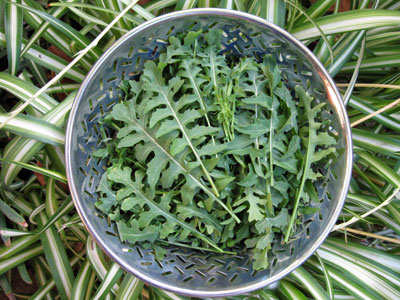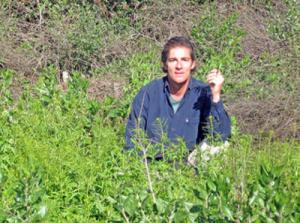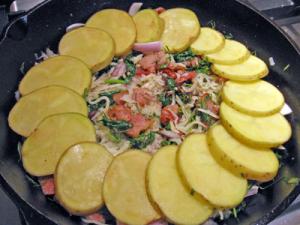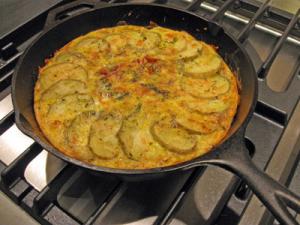 I live in the Hollywood Hills. My street backs up to some L.A. County conservancy property, which bleeds into Lake Hollywood and the land owned by Department of Water and Power, and culminates in 4200 acres of Griffith Park. That is a lot of wild land in the middle of one of the largest cities in the world.
I live in the Hollywood Hills. My street backs up to some L.A. County conservancy property, which bleeds into Lake Hollywood and the land owned by Department of Water and Power, and culminates in 4200 acres of Griffith Park. That is a lot of wild land in the middle of one of the largest cities in the world.
Which means I have eagles, deer, rabbit, hawks, bobcats, coyote and the occasional rumor of mountain lion as neighbors.
It also means easy access to hiking trails and the peace and solitude that comes from being in nature.
But whenever I hike these hills I find I have an annoying little habit. I am constantly scanning the trails for edibles. I have some tried and true areas where I collect citrus, figs, herbs, cactus fruit, blackberries and wild greens. But you never know when that lone indigenous Blue Elderberry tree will reveal it’s hiding place.
These edibles can be easy to find too, if you know what you are looking for.
In the arid, warm Mediterranean climate of Southern California There are lots of indigenous plants with culinary value. Including: Golden Currants, Wild Strawberries, Nettle, Sage, and Laurel (Bay Leaves).
But our climate supports various other types of edibles as well. Many have naturalized here. Some of the plants we now consider weeds were once very common edibles. Several of the most common weeds in the United States were actually imported from Europe generations ago as a food crop. This includes the despised scourge of the golf course– the dandelion, as well as fennel, and my personal favorite wild mustard greens.
Winter rain makes spring come early in California. Julie Andrews has nothin’ on these hills. Because they really are alive right now.
That means the tasty young leaves of wild mustard are everywhere.
It is a brief window however; soon these plants will bloom, washing the hillsides in gold. Which is pretty, but means they are past their prime. So to me that means harvest now and into the next few weeks.
It’s fun learning about the edible “weeds” in your area. It’s easy to learn where to look for them too. Many of these plants specialize in colonizing recently bare patches of earth. So you will often find them growing around construction sites. But care needs to be taken when harvesting wild edibles. You should avoid areas close to traffic or growing too near fire hydrants. Dog pee and diesel are not acceptable dressings in my opinion.
That’ why I look to the wild areas of Los Angeles. But just cause they are not covered in exhaust fumes does not mean you are carefree. There are a few things you should know:
 1. Start off with the easiest plants to identify. Mustard, for me, is just such a plant. There are poisonous plants out there. So it’s best to be very confident in your abilities to tell one from another.
1. Start off with the easiest plants to identify. Mustard, for me, is just such a plant. There are poisonous plants out there. So it’s best to be very confident in your abilities to tell one from another.
2. If you are serious get a book or rope a knowledgeable friend into helping you. You could also try an arranged tour specializing in edibles. In Los Angeles the Sierra Club and The Santa Monica Mountain Conservancy Group offer instructional tours.
3. Take the time to learn a few of the species scientific names. It will help you identify one type of amaranth from another. If you are going to do this you may as well get the tastiest types.
4. Use some common sense and a certain amount of respect. Treat wild plants with care. Don’t demolish an entire crop, especially before it has a chance to reseed. I like knowing from year to year, just where my mustard greens can be found. Careful harvesting also means you can be quite sure not to have grabbed a few fistfuls of hemlock along with that chickweed. Remember hemlock killed Socrates.
5. Lastly trust that gut feeling. If you are unsure about an ID, find the taste a bit too bitter, or that little voice in the back of your head says don’t eat that! Well then, DON’T EAT THAT!
I prefer wild foraging. But there is foraging for cultivated food as well. In my neighborhood there are fruit trees in almost every yard. Mostly citrus, but there are plums and figs aplenty too.
It’s hard to resist that perfect Meyer lemon, especially when it nearly bonks you in the head as you pass by on the sidewalk.
Honestly, I do not believe there is anything wrong with a little judicial neighborhood fruit harvest. Especially since the stuff growing on my street can be better than anything you can buy at the Safeway! Besides almost nobody can eat all 1,274 mandarin oranges every growing season.
Just so you know there are actual laws (at least in LA) governing what fruit is fair game to the urban forager. And fortunately the law is pretty much “use common sense”. The law states any fruit growing on a parkway strip, or on branches hanging over a sidewalk, roadway, or alley are yours for the taking. This does not mean you have the right to break branches or harm the tree in any way. So again, use common sense.
Another thing you should keep in mind is just because it is technically legal does not mean the practice will win you friends or stop your neighbors from getting angry when you greedily help yourself. So, if you plan on harvesting with regularity or feel the need to sample more than a fruit or 2, I really advise you to ask permission. You’ll find most people will simply say, “Help yourself!”
And, just so you know. I give as good as I take! I have a lemon tree by my front gate. Come on over any time and help yourself. The whole neighborhood does anyway!
But back to my mustard greens. I harvested a big bag recently and have decided to make a frittata with mustard greens, pancetta and potatoes.
Truthfully frittatas are one of those things you really do not need a recipe for. So I’ll give a few guidelines here.
First choose ingredients you love. I am choosing pancetta, potatoes, and of course my mustard greens.
You’ll want to pre-cook all the ingredients so that you don’t have to overcook the eggs to get the potatoes cooked through.
 I started by cutting thin discs from small round white potatoes. I added a bit of olive oil into a 10-inch cast iron skillet set over medium heat. Into the warm oil I added about 1 cup of pancetta in 1/4‑inch dice. Once it had rendered some fat, but before it got to brown I tossed a sliced shallot and 2 or 3 chopped green onions. Next I mixed in my greens. When these softened some, I mixed them into the pancetta and onions mixture. Then I gently added the potatoes in a single layer overlapping each other in a nice pattern all the way around the pan.
I started by cutting thin discs from small round white potatoes. I added a bit of olive oil into a 10-inch cast iron skillet set over medium heat. Into the warm oil I added about 1 cup of pancetta in 1/4‑inch dice. Once it had rendered some fat, but before it got to brown I tossed a sliced shallot and 2 or 3 chopped green onions. Next I mixed in my greens. When these softened some, I mixed them into the pancetta and onions mixture. Then I gently added the potatoes in a single layer overlapping each other in a nice pattern all the way around the pan.
Then I used a heat resistant dinner plate to act as a lid. I turned the heat down to low and steamed the potatoes until just barely cooked. Don’t let them get mushy. I like to keep them in their perfect round shape. It’s just prettier that way.
Meanwhile I lightly beat 6 eggs with about 1/2‑teaspoon thyme leaves and some salt and pepper. I poured the eggs over the potato mixture. Making sure I kept the potatoes undisturbed.
 I brought the heat back to medium and began to cook the eggs. I used a knife to constantly poke through the cooked part of the eggs letting some of the runny part come in contact with the pan.
I brought the heat back to medium and began to cook the eggs. I used a knife to constantly poke through the cooked part of the eggs letting some of the runny part come in contact with the pan.
Once the eggs have gelled up a bit, sprinkle about 1 cup of grated cheese over the top of the eggs. I chose a mild Fontina cheese.
Put the whole pan into a 450-degree oven until the top begins to brown and the eggs are completely cooked.
Serve hot or at room temperature.
Because I had so many mustard greens I also put together a small salad of fresh mustrad greens with red onion slivers and a red wine vinaigrette with a tiny bit of Dijon mixed in. So I guess you could say we had mustard 3 ways for dinner!

SERIOUS FUN FOOD
Greg Henry
SippitySup
Hiya! Happy Valentines day! I can’t believe i hadn’t came across your website earlier. I love it! Food should be all about fun! I completely agree.
i love your layout and your photos.… your website is so neat; im jealous! haha I can’t seem to pull myself together to organize it 🙁 Do inspire me.
Thanks for leaving a comment on my silly page; haha will be tagging you to my fav list.
Have fun today!
XOXO
This is from Su at The Journal of a Girl Who Loves to Cook! She has a very joyous wide-eyed love of life that always comes out in her entries. I go there sometimes when I am feeling blue. Her infectous enthusiasm for life always snaps me out of it. GREG